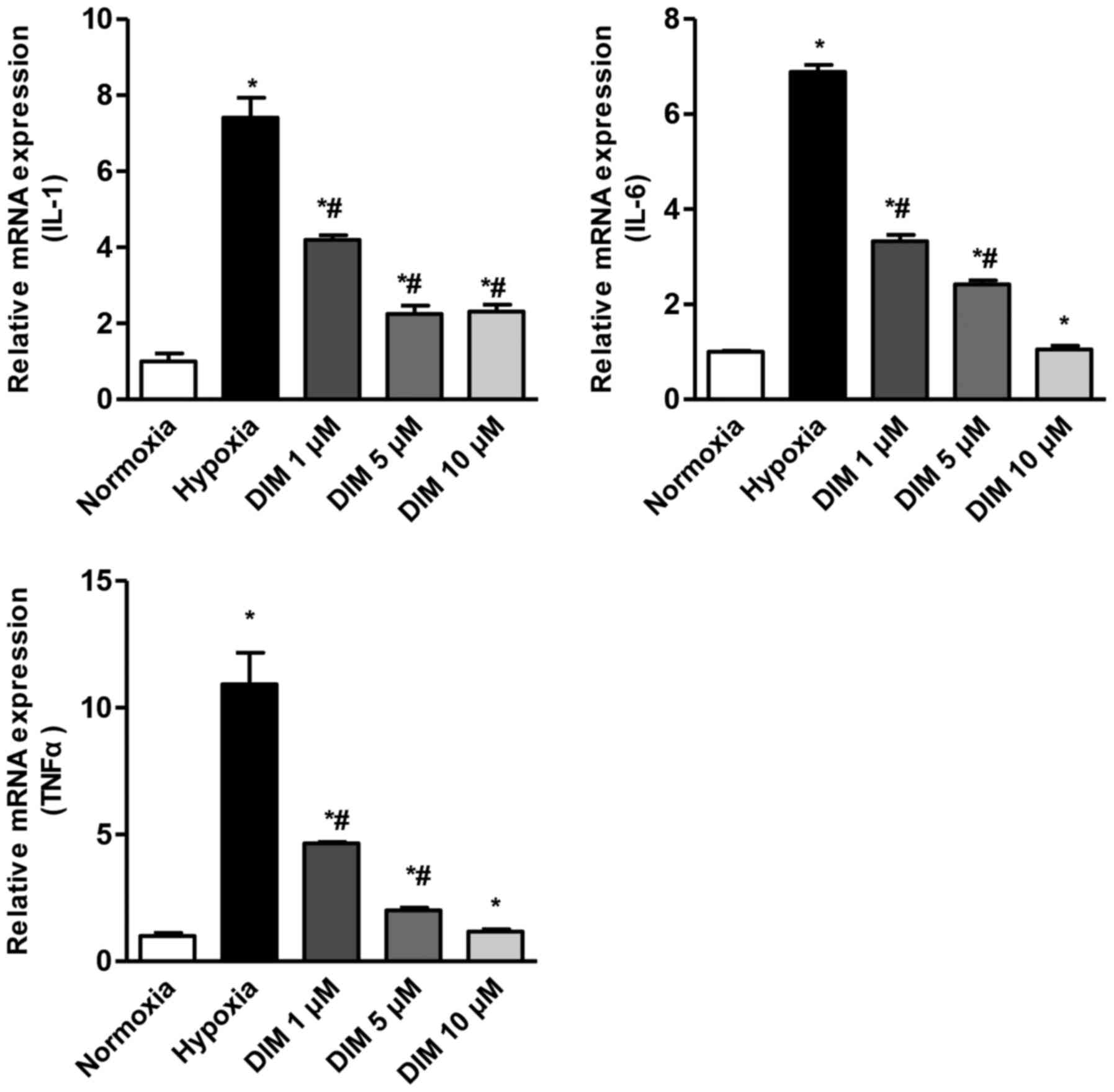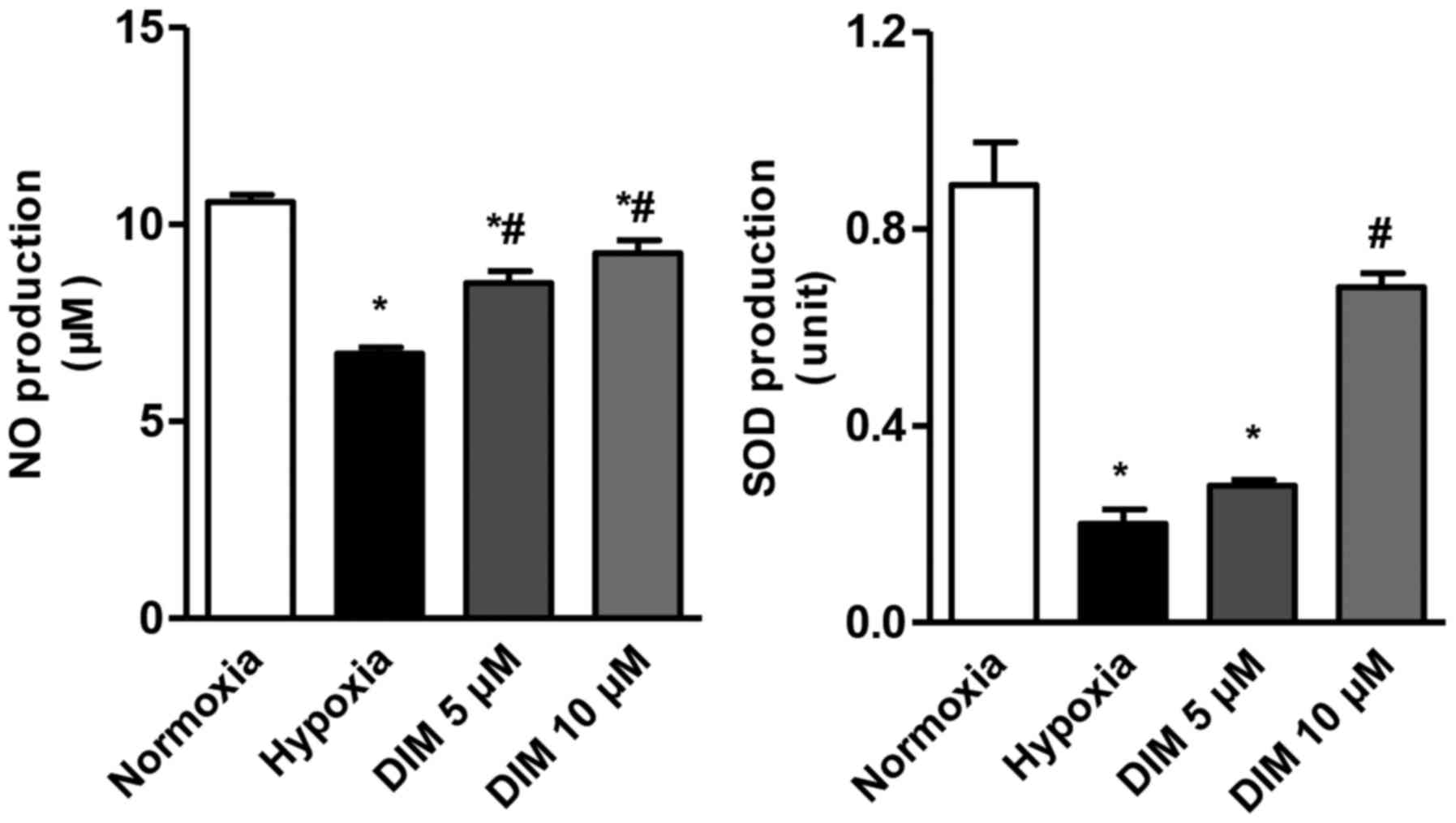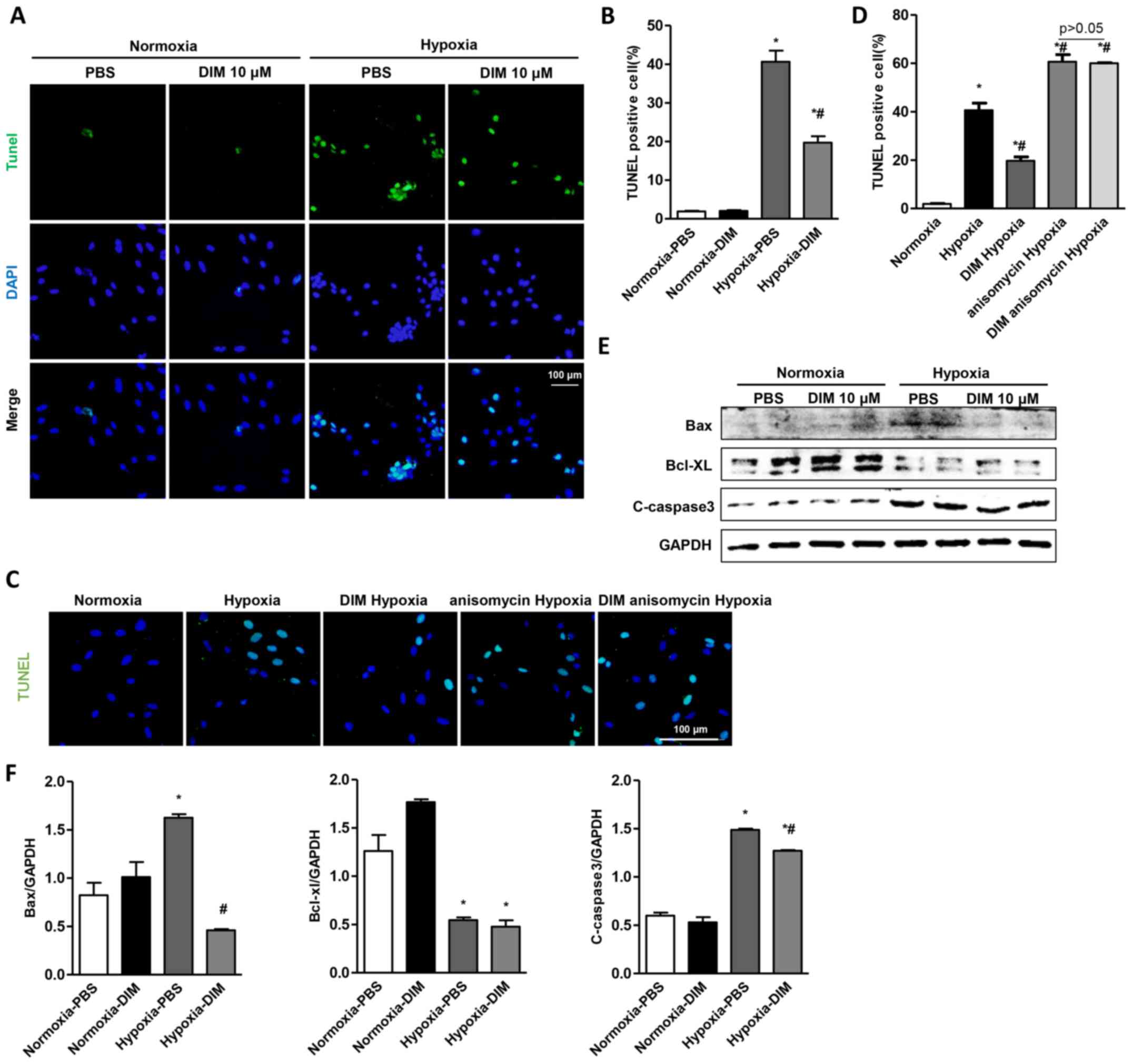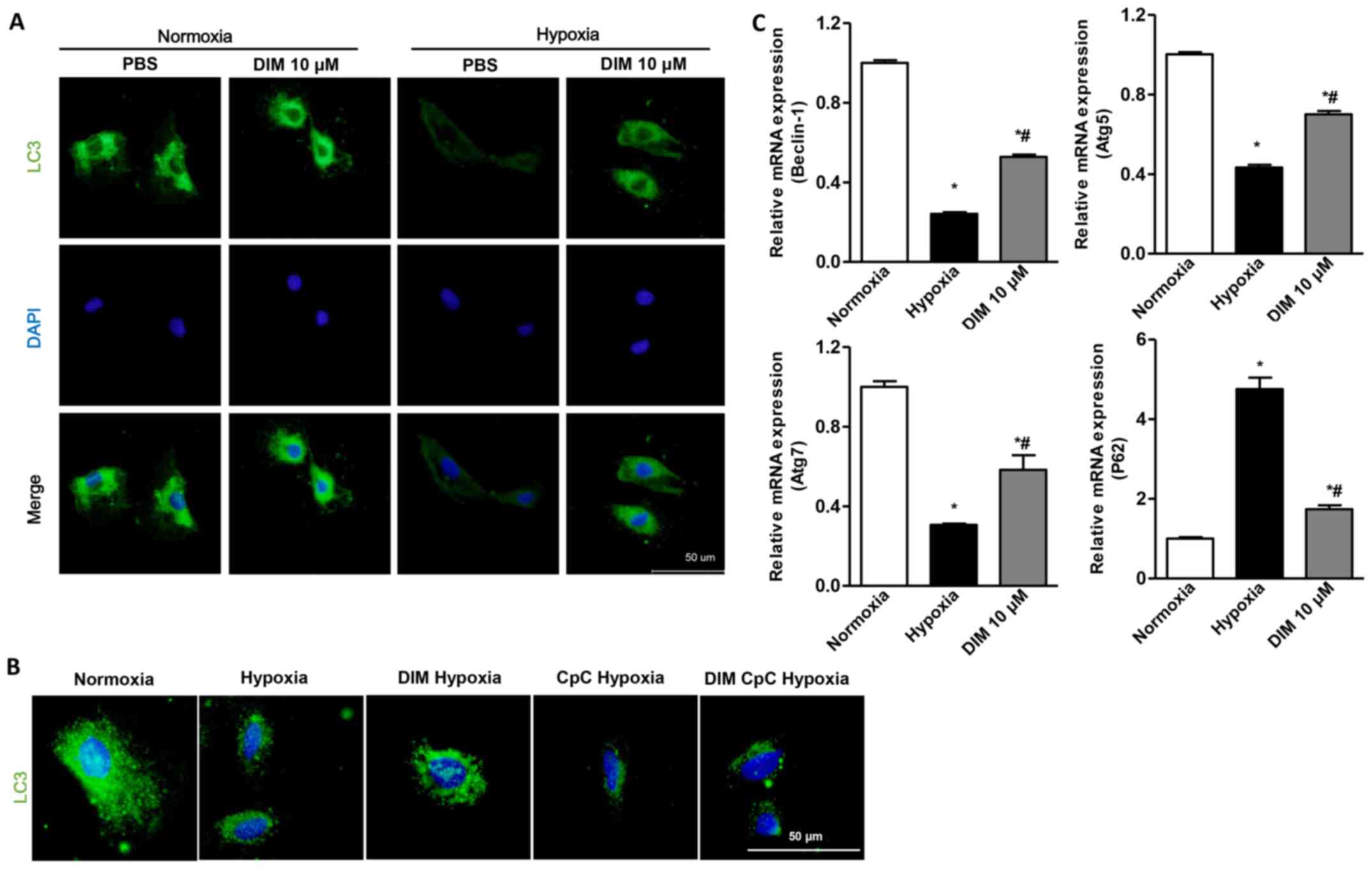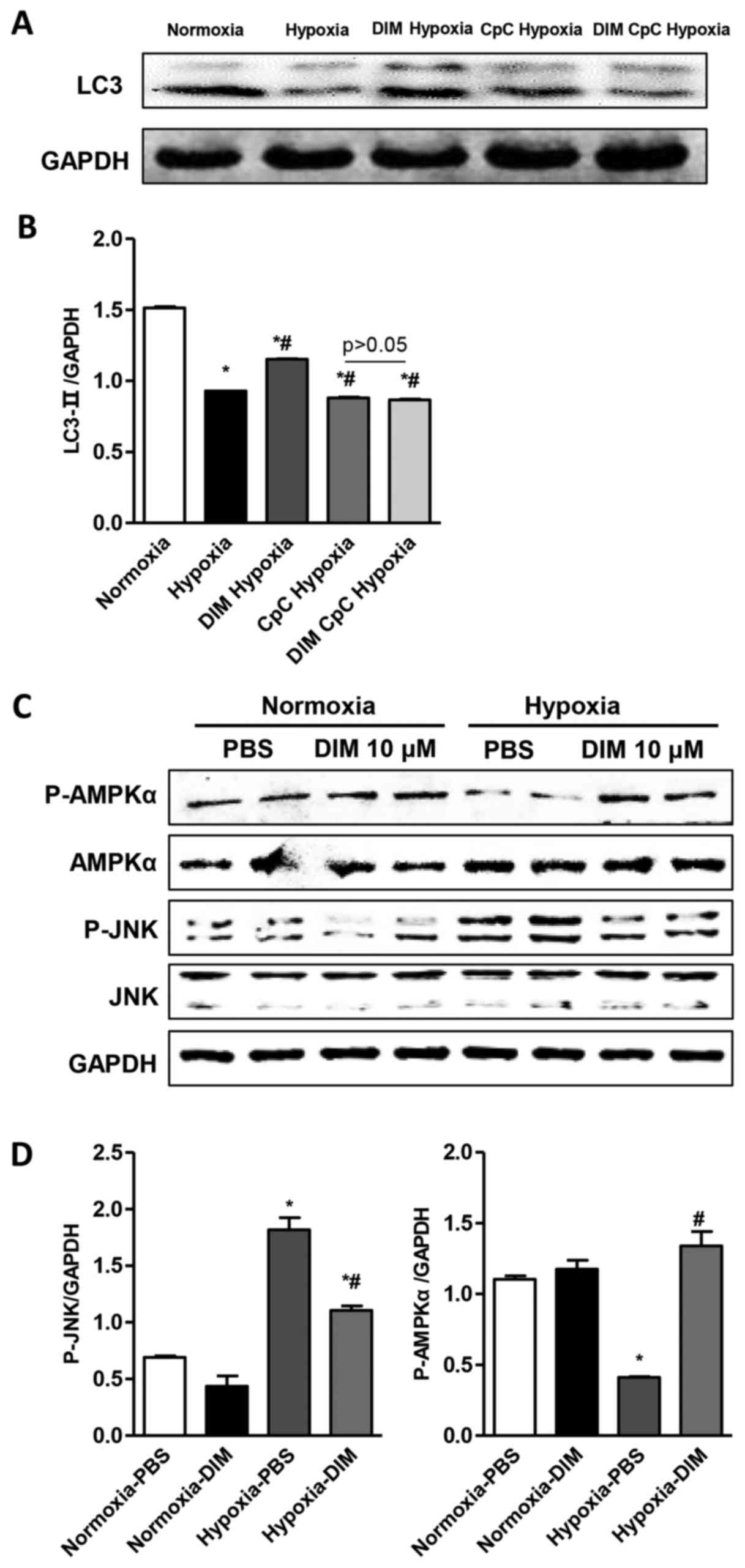3,3'‑Diindolylmethane attenuates cardiomyocyte hypoxia by modulating autophagy in H9c2 cells
- Authors:
- Published online on: October 13, 2017 https://doi.org/10.3892/mmr.2017.7788
- Pages: 9553-9560
Abstract
Introduction
Ischemic heart disease (IHD) is the main cause of death and disability in the world. The incidence of acute myocardial infarction (MI), a consequence of an imbalance between oxygen supply and demand, is growing in the global burden of IHD (1). Autophagy is a highly conserved intracellular degradation process that is an adaptive role to protect organisms against diverse pathologies, including infections, cancer, aging, and heart disease (2). Recent studies have showed that cardiomyocytes autophagy was activated in ischemic heart disease (3). The increase of autophagy is associated with the protective effect of ischemic preconditioning (4). However, the mechanistic process remains to be fully elucidated between myocardial ischemia and autophagy. Hence, cardiomyocytes autophagy may be a promising approach for the prevention of myocardial ischemia and progression to heart failure.
3,3′-Diindolylmethane (DIM) is extracted from natural product, derived from the acid-catalyzed condensation of indole-3-carbinol in cruciferous vegetables. Numerous studies have suggested that DIM has various pharmacological effects, including antioxidant, antitumor, anti-angiogenic, anti-inflammatory and anti-apoptotic (5–8). Meanwhile DIM could affect AMPKα and JNK signaling pathway (9,10). DIM could inhibit the proliferation of cancer cells through modulating autophagy (11). The previous studies showed that DIM attenuated TGFβ1-induced myofibroblast differentiation through down-regulated AKT/GSK-3β signaling pathways (12). The cardioprotective effects of DIM on cardiac hypertrophy are partly mediated through AMPKa signaling (13). It also improved myocardial energy metabolism imbalance induced by pressure overload via AMPKα in mice (14). All these studies indicate the protective effect of DIM on cardiovascular disease. However, it remains unknow whether DIM would protect cardiomyocyte from hypoxia injury. The purpose of the study was to evaluate the effect of DIM on hypoxia injury in cardiomyocytes and the underlying mechanism.
Materials and methods
Materials
The primary antibodies included phosphorylated (p)-AMPKα (sc101631; Santa Cruz Biotechnology, Inc., Santa Cruz, CA, USA), T-AMPKα (BS4046, BS1061, BS6271, respectively; Bioworld Technology Inc., St. Louis Park, MN, USA) and p-c-Jun N-terminal kinase (JNK) (4668P), T-JNK (9258), Bax (2722), Bcl-xl (2764P), C-caspase3 (9664) and GAPDH (2118) (all purchased from Cell Signaling Technology, Inc., Danvers, MA, USA). DIM was purchased from Sigma-Aldrich (St. Louis, MO, USA; D9568-5G) and dissolved in dimethyl sulfoxide (RNBC0311; Sigma-Aldrich) for the in vitro bioassay.
Cell culture
Rat cardiac H9c2 cells (Cell Bank of the Chinese Academy of Sciences, Shanghai, China) were cultured in Dulbecco's modified Eagle's medium (DMEM, C11995; Gibco-BRL, Carlsbad, CA, USA) supplemented with 10% fetal bovine serum (FBS; 10099-133; Gibco-BRL), 100 U/ml penicillin/100 mg/ml streptomycin (15140; Gibco-BRL) and 5% CO2 at 37°C. The media was exchanged every 2 days and subcultured to 70–80% confluency. Cells were plated at an appropriate density according to each experimental design. H9c2 cells were seeded in 6-well plates at a density of 0.25×106 cells/well. Cells were pretreated with DIM (1, 5, and 10 µM) in serum-free DMEM at 37°C for 12 h prior to the experiment. Cells were divided into four groups (Normoxia-PBS group, Normoxia-DIM group, Hypoxia-PBS group, Hypoxia-DIM group). Cell hypoxia used AnaeroPack-Anaero (Mitsubishi Gas Chemical Company, Inc., Tokyo, Japan) and anaerobic jar. The Pack could consume all the oxygen and produce equivalent carbon dioxide. H9c2 cells, anaerobic indicator and AnaeroPack were placed in anaerobic jar and immediately closed the jar lid. After approximately 30 min, the oxygen concentration decreased to less than 0.1%. The whole anoxic process was conducted at 37°C.
Quantitative polymerase chain reaction (qPCR)
qPCR was used to detect RNA expression levels of autophagy and fibrotic markers. Following 12 h pre-treatment with DIM, H9c2 cells were incubated with hypoxia for 12 h prior to the extraction of total RNA using TRIzol, and their yields and purities were spectrophoto metrically estimated using the A260/A280 and A230/260 ratios via a SmartSpec Plus Spectrophotometer (Bio-Rad Laboratories, Inc., Hercules, CA, USA). RNA (2 µg from each sample) was reverse-transcribed into cDNA using oligo (DT) primers (Sangon Biotech Co., Ltd., Shanghai, China) and the Transcriptor First Strand cDNA Synthesis kit (04896866001; Roche Diagnostics). PCR amplifications were quantified using the LightCycler 480 SYBR-Green I Master mix. GAPDH was used as the internal control. The PCR cycling conditions were as follows: Initial activation at 95°C for 10 min, followed by 40 cycles of 95°C for 15 sec and 60°C for 1 min. The sequences of the oligonucleotide primers (Sangon Biotech Co., Ltd.) were as follows: GAPDH, forward: 5′-GACATGCCGCCTGGAGAAAC-3′ and reverse: 5′-AGCCCAGGATGCCCTTTAGT-3′; IL-1β, forward: 5′-GGGATGATGACGACCTGCTAG-3′ and reverse: 5′-ACCACTTGTTGGCTTATGTTCTG-3′; IL-6, forward: 5′-GTTGCCTTCTTGGGACTGATG-3′ and reverse: 5′-ATACTGGTCTGTTGTGGGTGGT-3′; TNF-α, forward: 5′-AGCATGATCCGAGATGTGGAA-3′ and reverse: 5′-TAGACAGAAGAGCGTGGTGGC-3′; Beclin1, forward: 5′-AGCTTTTCTGGACTGTGTGC-3′ and reverse: 5′-TGAACTTGAGCGCCTTTGTC-3′; Atg7, forward: 5′-CACCAAAACAGATCCAGGCC-3′ and reverse: 5′-AGGGTGCTGGGTTAGGTTAC-3′; Atg5, forward: 5′-CAAGGATGCAGTTGAGGCTC-3′ and reverse: 5′-AGTTTCCGGTTGATGGTCCA-3′; P62 forward: 5′-AAGAGGCTCCATCACCAGAG-3′ and reverse: 5′-CCCCTTGACTCTGGCTGTAA-3′.
Anti-oxidative assessments
Anti-oxidative was assessed by the release of nitrite oxide (NO) and the activity of superoxide dismutase (SOD) according to the instructions (Beyotime Institute of Biotechnology, Shanghai, China). For NO detection, the supernatant was collected and transferred to another 96-well plate. Then NO released from H9c2 cells was measured at 540 nm using spectrophotometer according to the manufacturer's instructions (Beyotime Institute of Biotechnology). For SOD assessment, proteins were extracted and quantified before activity of SOD measurement at 450 nm using the commercial kit (Beyotime Institute of Biotechnology).
TUNEL staining
A TUNEL assay was performed to label apoptotic nuclei according to the manufacturer's instructions (ApopTag Plus Fluorescein In Situ Apoptosis Detection kit). Briefly, following 12 h pre-treatment with DIM (10 µM), cells were incubated with hypoxia for 12 h and subsequently fixed on coverslips in 1% paraformaldehyde in phosphate-buffered saline (both from Sinopharm Chemical Reagent Co., Ltd., Shanghai, China), stained with TUNEL reagents (EMD Millipore, Billerica, MA, USA) and DAPI (Invitrogen Life Technologies, Carlsbad, CA, USA) and observed under a microscope (BX51; Olympus Corp., Tokyo, Japan). The index of cell apoptosis was calculated as the percentage of apoptotic nuclei/total number of nuclei.
LC3 immunofluorescent staining
The effect of DIM on LC3 expression of cardiomyocytes hypoxia was examined by immunofluorescence method. Cells were grown on slides in 24-well plates and were pretreated with or without DIM. The cells were fixed in 4% paraformaldehyde and then permeabilised with 0.1% Triton X-100. After blocking with 8% goat serum for 60 min, the slides were incubated with rabbit polyclonal anti-LC3 in a 1:50 dilution. After 2 h of incubation in a chamber at 37°C, the slides were washed with phosphate-buffered saline (PBS) and incubated at 37°C for 1 h with a secondary goat anti-rabbit antibody conjugated to Alexa Fluor® 488. The cells on coverslips were mounted onto glass slides with Slow Fade Gold antifade reagent with DAPI (S36939; Invitrogen Life Technologies). The cells were observed using a DX51 microscope (Olympus Corp.) and images were taken with a camera.
Western blot analysis
Cultured cardiac H9c2 cells were lysed in radioimmuno precipitation (RIPA) lysis buffer and 50 µg cell lysate was used for protein separation by 10% SDS-PAGE. The proteins were then transferred to polyvinylidene difluoride (PVDF) membranes (Millipore Corp., Billerica, MA, USA). Specific protein expression levels were normalized to the GAPDH protein levels of the total cell lysate and cytosolic proteins on the same PVDF membranes. The following primary antibodies were used: p-AMPKα, T-AMPKα, p-JNK, T-JNK, LC3, Bax, Bcl-xl, C-caspase3 and GAPDH. Antibody incubation was performed overnight with gentle shaking at 4°C. Quantification of the western blots was performed using an Odyssey infrared imaging system (LI-COR Biosciences, Lincoln, NE, USA). Then the membranes were incubated with IRDye® 800CW conjugated secondary antibodies for 1 h. The blots were scanned using an infrared Li-Cor scanner, allowing for simultaneous detection of two targets (phosphorylated and total protein) within the same experiment.
Statistical analysis
Values are expressed as the mean ± standard error of the mean. Differences among groups were determined by one-way analysis of variance followed by Tukey's post hoc test. Comparisons between two groups were performed using an unpaired Student's t-test. P<0.05 was considered to indicate a statistically significant difference.
Results
DIM attenuates the inflammation in response to hypoxia in H9c2 cells
After H9c2 cardiomyocytes being expose to hypoxia for 12 h, the mRNA levels of IL-1β, IL-6 and TNF-α were significantly increased. We measured the effect of DIM with different concentration (1, 5 and 10 µM) in reduction of IL-1β, IL-6 and TNF-α in response to hypoxia (Fig. 1). As a result, DIM pretreatment markedly attenuated this increase of mRNA expression in H9c2 cells in a dose dependent maner.
Anti-oxidative ability of DIM in hypoxia-induced H9c2 cells
The effect of DIM at different concentrations (5 and 10 µM) on the production of NO and SOD in cardiomocytes exposed to hypoxia was measured. Compared with hypoxia group, the production of NO and SOD was increased after DIM pretreatment (Fig. 2). This result indicates that DIM protects against the oxidative injury induced by hypoxia. Since 10 µM DIM has a better performance, it was chosen for the further study.
DIM attenuates apoptosis in hypoxia-induced H9c2 cells
To demonstrate the protective role of DIM in hypoxia-induced apoptosis in H9c2 cells, TUNEL staining was used to detect the apoptotic nuclei. A significant increase in the number of TUNEL-positive nuclei was observed in H9c2 cells in the hypoxia group, whereas DIM pretreatment markedly reduced the percentage of TUNEL-positive cells induced by hypoxia (Fig. 3A and B). TUNEL staining also showed that the effect of DIM on hypoxia induced apoptosis was abolished after being pretreated with JNK activator (anisomycin, 40 ng/ml) (Fig. 3C and D). In addition, DIM decreased the protein expression of Bax and C-caspase3 comparable to hypoxia group, while increasing the protein Bcl-xl in H9c2 cells (Fig. 3E and F).
DIM activates autophagy in response to hypoxia in H9c2 cells
A significant decrease of LC3 expression through LC3 immunofluorescent staining was observed in H9c2 cells in the hypoxia group, whereas DIM pretreatment markedly increased LC3 expression induced by hypoxia (Fig. 4A). LC3 immunofluorescent staining also showed that the effect of DIM on autophagy was vanished after being pretreated with AMPKa inhibitor (CpC, 20 µM) following stimulation with hypoxia (Fig. 4B). Beclin1 plays a central role in autophagy induction. When autophagy occurs, Atg7 and Atg5 are located in the isolated membrane, thus facilitating the extension of the isolated membrane and forming the phagocytic vesicles. P62 is localized to the autophagosome formation site on the endoplasmic reticulum (ER). It is deposited in the cells when autophagy is reduced. After H9c2 cardiomyocytes being expose to hypoxia, the relative mRNA levels of Beclin1, Atg5, Atg7 decreased, and P62 increased. With the pretreatment of DIM, the Beclin1, Atg5, Atg7 increased, and P62 decreased in response to hypoxia (Fig. 4C). The results indicated that DIM (10 µM) ameliorated cardiomyocytes hypoxia injury via activating autophagy.
DIM promotes p-AMPKa activity and inhibits JNK signaling pathway in response to hypoxia in H9c2 cells
The mechanisms underlying the anti-inflmmatory, anti-apoptotic and pro-autophagy effects of DIM on hypoxia induced H9c2 cells injury were investigated via Western blot analysis. The Western blot analysis showed that DIM pretreatment increased LC3 expression induced by hypoxia. While the effect of DIM on LC3 expression was vanished after being pretreated with AMPKa inhibitor (CpC, 20 µM) following stimulation with hypoxia (Fig. 5A and B). The results showed that the phosphorylation and activation of AMPKα was inhibited and the phosphorylation and activation of JNK was increased after cardiomyocytes expose to hypoxia. In comparison, 10 µM DIM pretreatment increased the activation of AMPKα and decreased the phosphorylation of JNK (Fig. 5C and D). These findings indicates that DIM protects against cardiomyocytes hypoxia injury, may through stimulating p-AMPKα activity and inhibiting JNK signaling.
Discussion
The present study showed that DIM reduced the inflammation and apoptosis in response to hypoxia and increased the production of antioxidant NO and SOD. It also activated autophagy to exert anti-hypoxia effects in cardiomyocytes by regulating AMPKa and JNK signaling pathway.
Previous studies have showed that the inflammatory response induced by hypoxia in cardiomyocytes subsequently induces the induction of inflammatory mediators, including TNF-α, IL-1β and IL-6 (15,16). From cardiac injury to failure, inflammatory cytokines have been throughout the whole process (17). Therefore, it is very meaningful for myocardial ischemia to control inflammation (18). DIM is a possible option for inflammation in certain tissues and cells (19,20). The present study showed that DIM could decrease the expression of TNF-α, IL-1β and IL-6 in hypoxia-induced H9c2 cells injury model, which indicated the effect of DIM on inflammation. Anti-oxidative ability of DIM was performed by the detection of intracellular ROS, the release of intracellular NO and the activity of intracellular SOD (21). NO, the main effect of the expansion of blood vessels, attenuates myocardial ischemia (22). SOD can resist cell damage caused by oxygen free radicals and timely repair of damaged cells, reflecting the body's ability to clear free radicals, in particular, to reflect the capacity of clearing superoxide anion (23). Increased levels of NO and SOD partly contribute towards the action of DIM to attenuate cardiomyocyte hypoxia injury.
Myocardial apoptosis is involved in many cardiovascular diseases, including myocardial hypertrophy, heart failure, diabetic cardiomyopathy, ischemia/reperfusion injury (24). The present study indicated that DIM attenuated hypoxia-induced cardiomyocyte apoptosis. The balance between regulation of apoptotic protein Bax and anti-apoptotic protein Bcl-2 determines cells undergo apoptosis or survive (25). The results showed that DIM pretreatment downregulated the Bax and C-caspase3, meanwhile the levels of Bcl-xl remained unchanged in cardiomyocyte with hypoxia injury on DIM pretreatment. Activation of JNK, members of the mitogen-activated protein kinase family, has been reported to be induced by hypoxia (26). Following activation, JNK phosphorylated a wide array of intracellular targets, resulting in the reprogramming of cardiac gene expression, the inflammation and apoptosis of cardiomyocytes (27). Inhibition of the JNK pathways in cardiomyocytes results in attenuated hypertrophic growth induced by agonist stimulation (28). In addition, previous studies have demonstrated that the activation of JNK is involved in the induction of the inflammatory response and apoptosis (29,30). The present study revealed that DIM inhibited the phosphorylation of JNK in hypoxia-induced H9c2 cells, which indicated that the anti-apoptosis effect of DIM may mediated by blocking JNK pathway.
Autophagy is a conserved metabolic process, and cellular components are transported to the lysosomal degradation (31). Many studies have showed that autophagy is involved in the pathogenesis of acute and chronic ischemia heart injury and heart failure (32,33). Emerging studies have demonstrated that autophagy is significantly upregulated in cardiomyocytes ischemia, suggesting a role of autophagy in the process of ischemia injury (34). Autophagy is stimulated by myocardial ischemia and exert protective effect during myocardial ischemia (35). The autophagy pathway was involved in the cardio-protective effect induced by ischemic preconditioning (IPC) (36). The cardiomyocyte-specific knockout of Atg7 aggravates the Myocardial ischemia injury (37). AMPK-mediated autophagy has been shown to play a possible protective role during myocardial ischemia (38). AMPKα can not only regulate autophagy through mTOR-TSC2, but also leads to autophagy by direct phosphorylation of ULK1 (39,40). Beclin1 (mammalian ortholog of yeast Atg6) has a central role in autophagy and it is a key autophagic protein regulating both autophagosome formation and processing (41). When autophagy occurs, Atg16 is combined with Atg12-Atg5 to form an Atg16-Atg12-Atg5 complex. The complex is located on the isolation membrane, which promotes the extension of the isolation film and forms a phagocytic bubble (42). P62, a multifunctional ubiquitin-binding protein, localizes to the autophagosome formation site on the ER, where autophagosomes are nucleated (43). It plays a critical role in cell's selective autophagy and oxidative stress response (44). In the current study, we found that pretreatment with DIM could activate autophagy, as revealed by the upregulated expression of Atg5, Atg7 and Beclin1 and decreased level of P62 in hypoxia-induced H9c2 cells. And the pro-autophagy effect of DIM may through activation of AMPKα.
In conclusion, the present study indicated that DIM attenuated the inflammation and apoptosis in response to hypoxia in H9c2 cells. DIM also activated autophagy in response to hypoxia in H9c2 cells. DIM protected against hypoxia induced cardiomyocyte injury. The effect may be mediated by activation of AMPKα and inhibition of JNK pathways. These observations may provide experimental evidence for the application of DIM in the protective effect of myocardial ischemia in cardiovascular diseases.
Acknowledgements
The present study was supported by the National Natural Science Foundation of China (grant no. 81400178) and the Natural Science Foundation of Jiangsu Province (grant nos. BK20140226 and BK20160231).
References
|
Frangogiannis NG: Pathophysiology of myocardial infarction. Compr Physiol. 5:1841–1875. 2015. View Article : Google Scholar : PubMed/NCBI | |
|
Levine B and Kroemer G: Autophagy in the pathogenesis of disease. Cell. 132:27–42. 2008. View Article : Google Scholar : PubMed/NCBI | |
|
Rothermel BA and Hill JA: Myocyte autophagy in heart disease: Friend or foe? Autophagy. 3:632–634. 2007. View Article : Google Scholar : PubMed/NCBI | |
|
Yan WJ, Dong HL and Xiong LZ: The protective roles of autophagy in ischemic preconditioning. Acta Pharmacol Sin. 34:636–643. 2013. View Article : Google Scholar : PubMed/NCBI | |
|
Jayakumar P, Pugalendi KV and Sankaran M: Attenuation of hyperglycemia-mediated oxidative stress by indole-3-carbinol and its metabolite 3,3′-diindolylmethane in C57BL/6J mice. J Physiol Biochem. 70:525–534. 2014. View Article : Google Scholar : PubMed/NCBI | |
|
Kunimasa K, Kobayashi T, Kaji K and Ohta T: Antiangiogenic effects of indole-3-carbinol and 3,3′-diindolylmethane are associated with their differential regulation of ERK1/2 and Akt in tube-forming HUVEC. J Nutr. 140:1–6. 2010. View Article : Google Scholar : PubMed/NCBI | |
|
Cho HJ, Seon MR, Lee YM, Kim J, Kim JK, Kim SG and Park JH: 3,3′-Diindolylmethane suppresses the inflammatory response to lipopolysaccharide in murine macrophages. J Nutr. 138:17–23. 2008.PubMed/NCBI | |
|
Azmi AS, Ahmad A, Banerjee S, Rangnekar VM, Mohammad RM and Sarkar FH: Chemoprevention of pancreatic cancer: Characterization of Par-4 and its modulation by 3,3′ diindolylmethane (DIM). Pharm Res. 25:2117–2124. 2008. View Article : Google Scholar : PubMed/NCBI | |
|
Chen D, Banerjee S, Cui QC, Kong D, Sarkar FH and Dou Q: Activation of AMP-activated protein kinase by 3,3′-Diindolylmethane (DIM) is associated with human prostate cancer cell death in vitro and in vivo. PloS One. 7:e471862012. View Article : Google Scholar : PubMed/NCBI | |
|
Xue L, Firestone GL and Bjeldanes LF: DIM stimulates IFNgamma gene expression in human breast cancer cells via the specific activation of JNK and p38 pathways. Oncogene. 24:2343–2353. 2005. View Article : Google Scholar : PubMed/NCBI | |
|
Ye Y, Fang Y, Xu W, Wang Q, Zhou J and Lu R: 3,3′-Diindolylmethane induces anti-human gastric cancer cells by the miR-30e-ATG5 modulating autophagy. Biochem Pharmacol. 115:77–84. 2016. View Article : Google Scholar : PubMed/NCBI | |
|
Li J, Zhang W, Jiao R, Yang Z, Yuan Y, Wu Q, Hu Z, Xiang S and Tang Q: DIM attenuates TGF-β1-induced myofibroblast differentiation in neonatal rat cardiac fibroblasts. Int J Clin Exp Pathol. 8:5121–5128. 2015.PubMed/NCBI | |
|
Zong J, Wu QQ, Zhou H, Zhang JY, Yuan Y, Bian ZY, Deng W, Dai J, Li FF, Xu M, et al: 3,3′-Diindolylmethane attenuates cardiac H9c2 cell hypertrophy through 5′-adenosine monophosphate-activatedprotein kinase-α. Mol Med Rep. 12:1247–1252. 2015. View Article : Google Scholar : PubMed/NCBI | |
|
Deng W, Zong J, Wei L, Guo H, Cheng Z, Zhang R, Lin Y and Tang Q: 3,3′-Diindolylmethane improves myocardial energy metabolism imbalance induced by pressure overload via AMPKα in mice. Int J Cardiol. 177:235–237. 2014. View Article : Google Scholar : PubMed/NCBI | |
|
Liu S, Mao J, Wang T and Fu X: Downregulation of aquaporin-4 protects brain against hypoxia ischemia via anti-inflammatory mechanism. Mol Neurobiol. Oct 10–2016.(Epub ahead of print). | |
|
Cheng CY: Anti-inflammatory effects of traditional Chinese medicines against ischemic injury in in vivo models of cerebral ischemia. Evid Based Complement Alternat Med. 2016:57394342016. View Article : Google Scholar : PubMed/NCBI | |
|
González A, Ravassa S, Beaumont J, López B and Díez J: New targets to treat the structural remodeling of the myocardium. J Am Coll Cardiol. 58:1833–1843. 2011. View Article : Google Scholar : PubMed/NCBI | |
|
Cuenca-López MD, Brea D, Galindo MF, Antón-Martínez D, Sanz MJ, Agulla J, Castillo J and Jordán J: Inflammatory response during ischaemic processes: Adhesion molecules and immunomodulation. Rev Neurol. 51:30–40. 2010.(In Spanish). PubMed/NCBI | |
|
Jeon EJ, Davaatseren M, Hwang JT, Park JH, Hur HJ, Lee AS and Sung MJ: Effect of oral administration of 3,3′-diindolylmethane on dextran sodium sulfate-induced acute colitis in mice. J Agric Food Chem. Oct 4–2016.(Epub ahead of print). View Article : Google Scholar | |
|
Rzemieniec J, Litwa E, Wnuk A, Lason W, Krzeptowski W and Kajta M: Selective aryl hydrocarbon receptor modulator 3,3′-diindolylmethane impairs AhR and ARNT signaling and protects mouse neuronal cells against hypoxia. Mol Neurobiol. 53:5591–5606. 2016. View Article : Google Scholar : PubMed/NCBI | |
|
Sun HJ, Wang Y, Hao T, Wang CY, Wang QY and Jiang XX: Efficient GSH delivery using PAMAM-GSH into MPP-induced PC12 cellular model for Parkinson's disease. Regen Biomater. 3:299–307. 2016. View Article : Google Scholar : PubMed/NCBI | |
|
Rong B, Xie F, Sun T, Hao L, Lin MJ and Zhong JQ: Nitric oxide, PKC-ε, and connexin43 are crucial for ischemic preconditioning-induced chemical gap junction uncoupling. Oncotarget. 7:69243–69255. 2016.PubMed/NCBI | |
|
Zhang WP, Zong QF, Gao Q, Yu Y, Gu XY, Wang Y, Li ZH and Ge M: Effects of endomorphin-1 postconditioning on myocardial ischemia/reperfusion injury and myocardial cell apoptosis in a rat model. Mol Med Rep. 14:3992–3998. 2016. View Article : Google Scholar : PubMed/NCBI | |
|
Corbalan J Jose, Vatner DE and Vatner SF: Myocardial apoptosis in heart disease: Does the emperor have clothes? Basic Res Cardiol. 111:312016. View Article : Google Scholar : PubMed/NCBI | |
|
Tichý A: Apoptotic machinery: The Bcl-2 family proteins in the role of inspectors and superintendents. Acta Medica (Hradec Kralove). 49:13–18. 2006.PubMed/NCBI | |
|
Wu X, Gu W, Lu H, Liu C, Yu B, Xu H, Tang Y, Li S, Zhou J and Shao C: Soluble receptor for advanced glycation end product ameliorates chronic intermittent hypoxia induced renal injury, inflammation and apoptosis via P38/JNK signaling pathways. Oxid Med Cell Longev. 2016:10153902016. View Article : Google Scholar : PubMed/NCBI | |
|
Balakumar P and Jagadeesh G: Multifarious molecular signaling cascades of cardiac hypertrophy: Can the muddy waters be cleared? Pharmacol Res. 62:365–383. 2010. View Article : Google Scholar : PubMed/NCBI | |
|
Liang Q and Molkentin JD: Redefining the roles of p38 and JNK signaling in cardiac hypertrophy: Dichotomy between cultured myocytes and animal models. J Mol Cell Cardiol. 35:1385–1394. 2003. View Article : Google Scholar : PubMed/NCBI | |
|
Liu T, Wang G, Tao H, Yang Z, Wang Y, Meng Z, Cao R, Xiao Y, Wang X and Zhou J: Capsaicin mediates caspases activation and induces apoptosis through P38 and JNK MAPK pathways in human renal carcinoma. BMC Cancer. 16:7902016. View Article : Google Scholar : PubMed/NCBI | |
|
Tien YC, Lin JY, Lai CH, Kuo CH, Lin WY, Tsai CH, Tsai FJ, Cheng YC, Peng WH and Huang CY: Carthamus tinctorius L. prevents LPS-induced TNFalpha signaling activation and cell apoptosis through JNK1/2-NFkappaB pathway inhibition in H9c2 cardiomyoblast cells. J Ethnopharmacol. 130:505–513. 2010. View Article : Google Scholar : PubMed/NCBI | |
|
Klionsky DJ and Emr SD: Autophagy as a regulated pathway of cellular degradation. Science. 290:1717–1721. 2000. View Article : Google Scholar : PubMed/NCBI | |
|
Costa R, Morrison A, Wang J, Manithody C, Li J and Rezaie AR: Activated protein C modulates cardiac metabolism and augments autophagy in the ischemic heart. J Thromb Haemost. 10:1736–1744. 2012. View Article : Google Scholar : PubMed/NCBI | |
|
Yan L, Vatner DE, Kim SJ, Ge H, Masurekar M, Massover WH, Yang G, Matsui Y, Sadoshima J and Vanter SF: Autophagy in chronically ischemic myocardium. Proc Natl Acad Sci USA. 102:pp. 13807–13812. 2005; View Article : Google Scholar : PubMed/NCBI | |
|
Hamacher-Brady A, Brady NR and Gottlieb RA: Enhancing macroautophagy protects against ischemia/reperfusion injury in cardiac myocytes. J Biol Chem. 281:29776–29787. 2006. View Article : Google Scholar : PubMed/NCBI | |
|
Matsui Y, Takagi H, Qu X, Abdellatif M, Sakoda H, Asano T, Levine B and Sadoshima J: Distinct roles of autophagy in the heart during ischemia and reperfusion: Roles of AMP-activated protein kinase and Beclin 1 in mediating autophagy. Circ Res. 100:914–922. 2007. View Article : Google Scholar : PubMed/NCBI | |
|
Peng W, Liu Y, Xu WJ and Xia QH: Role of Beclin 1-dependent autophagy in cardioprotection of ischemic preconditioning. J Huazhong Univ Sci Technolog Med Sci. 33:51–56. 2007. View Article : Google Scholar | |
|
Li S, Liu C, Gu L, Wang L, Shang Y, Liu Q, Wan J, Shi J, Wang F, Xu Z, et al: Autophagy protects cardiomyocytes from the myocardial ischaemia-reperfusion injury through the clearance of CLP36. Open Biol. 6:1601772016. View Article : Google Scholar : PubMed/NCBI | |
|
Nishida K, Kyoi S, Yamaguchi O, Sadoshima J and Otsu K: The role of autophagy in the heart. Cell Death Differ. 16:31–38. 2009. View Article : Google Scholar : PubMed/NCBI | |
|
Shackelford DB and Shaw RJ: The LKB1-AMPK pathway: Metabolism and growth control in tumour suppression. Nat Rev Cancer. 9:563–575. 2009. View Article : Google Scholar : PubMed/NCBI | |
|
Kim J, Kundu M, Viollet B and Guan KL: AMPK and mTOR regulate autophagy through direct phosphorylation of Ulk1. Nat Cell Biol. 13:132–141. 2009. View Article : Google Scholar | |
|
Kang R, Zeh HJ, Lotze MT and Tang D: The Beclin 1 network regulates autophagy and apoptosis. Cell Death Differ. 18:571–580. 2011. View Article : Google Scholar : PubMed/NCBI | |
|
Barth S, Glick D and Macleod KF: Autophagy: Assays and artifacts. J Pathol. 221:117–124. 2010. View Article : Google Scholar : PubMed/NCBI | |
|
Itakura E and Mizushima N: p62 targeting to the autophagosome formation site requires self-oligomerization but not LC3 binding. J Cell Biol. 192:17–27. 2011. View Article : Google Scholar : PubMed/NCBI | |
|
Liu SM, Dong YJ and Liu B: Progress of study on p62 and protein degradation pathways. Sheng Li Xue Bao. 67:48–58. 2015.PubMed/NCBI |



